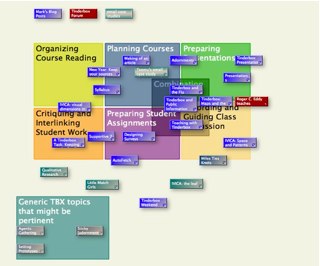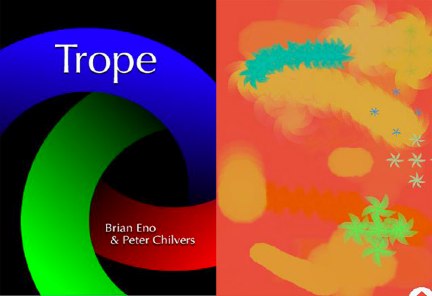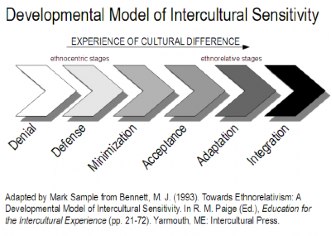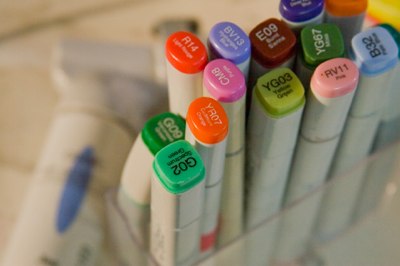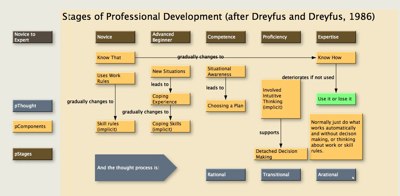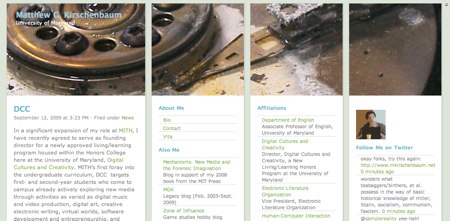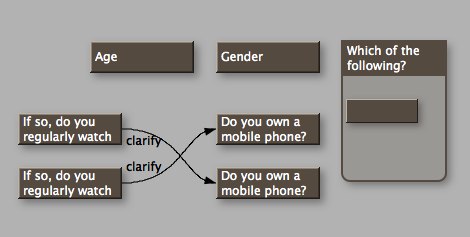Dene Grigar hails the results of the 24-Hr. Micro-Elit Project. “Over 85 stories were submitted by 25+ participants from five countries,” she says. Also of interest to fans of Twitter-narrative is Laurent Sauerwein’s Taploid project, though these Tweets are individual narratives while Taploid’s episodic tweets come together to form a narrative.
The two approaches offer different experiences and raise different questions. Taploid recounts a trip to South India over the course of several Tweets, emphasizing social media networks as a medium for imparting episodic narrative. The question is, at what point do we separate the cheese sandwiches and trivial experience from the serious literary narratives? Or do we? How do we criticize such a piece?
The 24hr project is more concerned with a collaborative effort to create stories no longer than 140 characters, à la Hemingway’s famous “For sale: baby shoes, never worn.” Here we face the familiar flash fiction question: how short is too short? Whatever that threshold is, I would argue that we haven’t reached it yet, as the stories in the 24 hr project are still able to invoke emotion and understanding of character. Some of my favorites:
Thanks to Jill Walker Rettberg for link.
An interesting discussion has arisen on the Tinderbox forums on using Tinderbox as a tool for teaching.
One user lamented that the map view does not represent hierarchy as well as the outline view, but the outline view does not allow for the level of visualization (or aesthetically pleasing visuals for class presentation) that the map view allows.
The trick here is that both views are used for different tasks, so you don’t always need both. When both seem like a good idea, you can use adornments and separators to create a workable pseudo-hierarchy that won’t interfere with the other view. Some people unaccustomed to working with such a dynamic tool try to anticipate all the structure they are going to need ahead of time. The key is to only use what you need; those adornments and separators can always become containers later if you really need them.
Brian Eno has introduced his new app for the iPhone and iPod touch, Trope. The new app is a follow-up to Bloom, an application that would create different sounds and images when the user moved her finger around the screen. Eno explains,
“Trope is a different emotional experience from Bloom—more introspective, more atmospheric. It shows that generative music…can draw from a palette of moods.”
The blend of music, visual art, and user interaction make this a very interesting app—more interesting when you ask how we should think about or critique this type of art.
Ton Zylstra points out the poignancy of a 17-year-old referring to all forms of internet-enabled hardware as “screens.” The term emphasizes the importance of the information shared by trivializing how that information is imparted. It doesn’t matter if you access the internet through your phone, laptop, portable gaming system, desktop PC, iPod, etc.—they are all screens.
The Boston Modern Orchestra Project is dedicated to the recording and performing of new orchestral music from the 20th and 21st centuries.
Often even the experienced concert-goer will complain that these pieces are strange, experimental, disjointed, or hard-to-understand—many of the same complaints that plague new media. What struck me about the project was the unusual critical and commercial success the group seems to be enjoying from playing these pieces. In a time when music CDs are tough to sell, and the enterprise of classical recording seems almost at an end, BMOP has launched an ambitious, award-winning (and apparently profitable) catalog of new works on CD (some downloadable from their site for $0.99), including John Harbison's ballet Ulysses and Gunther Schuller’s Journey in Jazz.
In the Wall Street Journal, a great article by Terry Teachout on The New-Media Crisis of 1949 which details the decline of network radio. The music, television, and print industries should be taking notes. Sentimentality won’t save a medium, and those who embrace the new form tend to be more successful. Thanks. George Landow!
In The New Yorker, Anthony Grafton offers a closer look at Google’s book project. A recent deal with On Demand Books will allow the printing of two million out-of-copyright digital texts on the Espresso Book Machine; and Grafton suggests this will lead Google toward becoming the “largest bookstore the world has ever known.” According to On Demand Books, the Espresso Book Machine offers “library quality paperbacks…which have full color covers” and are “indistinguishable from other books sold in bookstores” in under five minutes.
The article touches on many of the issues facing the project, including the legal issues surrounding copyright protection, the ethical issues of using the Internet as a means of controlling information, and the previously mentioned quality problems with Google’s categorization process.
Grafton wrote The Footnote, which Mark Bernstein describes as “indispensable for understanding the backstory of hypertext.”
In The Chronicle of Higher Education, Geoffrey Nunberg calls Google’s book search a disaster for scholars.
“Whether the Google books settlement passes muster with the U.S. District Court and the Justice Department, Google's book search is clearly on track to becoming the world's largest digital library. No less important, it is also almost certain to be the last one.”
The article points out errors in the scanned books’ metadata including category listings, publication dates and even titles. Google has already faced criticism for the legal and ethical aspects of creating a digital library, but this is the first article I’ve seen that addresses the quality of the project’s execution. Thanks, TiltFactor.
Inside Higher Ed interviews Dennis Baron of University of Illinois at Urbana-Champaign about his new book, A Better Pencil: Readers, Writers, and the Digital Revolution .
The interview discusses the digitization of writing, addressing claims that technologies like email and text-messaging are destroying children’s capacity to write and disputing the idea that computers and online learning will replace face-to-face teaching. Baron also discusses Google’s book project .
In a new post to her blog, Susan Gibb discusses revising her latest hypertext, Blueberries. She describes how slight changes to wording can alter the meaning of a particular node, allowing for possible interpretations that even the writer didn’t catch the first time.
Meanwhile, Diane Greco (who has just taken up a new post at Boston University) talks about the obstacles to starting a story — and also about how writing letters builds identity. She picks out a wonderful comment from another writer’s weblog:
How many layers of imagination are piled in this buttery biscuit of a note?
Mark Sample of George Mason University speculates at netpoetic.com about “Teaching Electronic Literature as a Foreign Land”. (An earlier version of the essay appeared on his blog .) The essay asks, “would the same process by which a stranger in a strange land grows accustomed to foreignness and even appreciates and incorporates cultural difference into his or her own life — could that process apply to e-lit?”
The essay discusses how the six stage model of intercultural sensitivity, designed by Milton J. Bennett, seems to apply to his students’ reactions to their first encounter with electronic literature.
Student reactions to specific hypertexts are often surprising. In Reading Hypertext, Michael Joyce mentions that students often seem to dislike Mary-Kim Arnold’s masterful “Lust”, though Rich Higgason’s study of “Lust” certainly demonstrated that students have plenty of opinions on the work.
Dan Bricklin has posted a new essay to his website entitled “Signals and the Ubiquity of New Carriers”. Bricklin created VisiCalc, the first computer program for making spreadsheets.
"Entire capital and distribution infrastructure may be quickly obsoleted when a major type of signal starts switching to be more commonly carried by a different type of carrier. The quality and price improvements they may have been working on may have little sway against the desirability of totally different attributes of the new carriers. Signal producers often give little thought to the fact that adding a new carrier may cause demand for the services of one of their carriers to drop.”
The article focuses on changing technologies, past and present, examining their impact on the way we receive information. Looking at the article from the standpoint of a young, technologically-dependent art form, it’s interesting to envision where hypertext literature may go in the coming years.
Wireframes, a site for information architects, reminds us that this is the season for pen, pencil and marker sets.
There’s something about a crisp September morning that makes you want to go out and grab a big box of something with lots of colors. Don’t forget colored pencils, which have improved substantially since you were a kid; get an electric sharpener and you’re good to go. When you were six, you probably cared about fluorescent greens and school bus yellows, but nowadays you’ll find surprising uses for a range of grays and neutrals and earth tones.
Wireframes sometimes attracts unusually good comments, too.
In her blog, Susan Gibb discusses the process of writing and revision for her new hypertext, Blueberries:
“So what is the impetus for selection [of which link to follow]? Does it depend upon the individual as far as style (first, second, third link in order) or experience either of reading hypertext or of knowledge of the author’s style? Is it the text itself that creates desire to go further in that direction, whether it be the single word (or phrase) that is obviously the link, or the context in which the link resides?”
Gibb is able to trace the path of her readers, finding out which link they clicked on and how far they went afterwards. She uses this information to revise the text— fascinating!
Be sure to check out the comments as well, as she brings up interesting points of discussion on the fact that a reader might be done with the piece and not have visited every link:
“As far as am I okay with a reader missing many of my most eloquently written spaces, I’m getting used to it. There are two evident solutions for the author to take: 1) ensure that the paths lead through the story in a way that would both please the reader and satisfy the writer, and 2) more importantly, make each and every writing space a piece of art.”
Roger C. Eddy is a practicing psychoanalyst/psychiatrist who teaches psychotherapy to M.D.s using Tinderbox. In his recent post to the Tinderbox forum, Eddy describes how he uses the map view to teach theories introduced in Mind Over Machine by Hubert and Stuart Dreyfus. He writes:
by Hubert and Stuart Dreyfus. He writes:
“the visual guide allows a quicker grasp for the students of the rather complex arguments of the book. In other words they get the "gestalt" and then can nibble away at the author's' examples.”
Eddy also uses the map view to create hypertexts with his students, building the map together over the course of several lectures. He believes that “the students have found it useful.”
In a showing of true creative fortitude, Steve Ersinghaus and friends have finished the 2009 incarnation of the 100 Days project. The project invited artists of different fields to create a new work in their respective area of interest each day for 100 days. Susan Gibb, who was tasked with creating a new work of hypertext each day, explains how the project began:
The 100 Days Project started as a spinoff from last year's collaboration between Steve Ersinghaus and Carianne Mack , Steve writing a poem to match Carianne's watercolor paintings. As teachers, they both had some time during the summer to be creative and decided to produce work every day for 100 days and posted each one at Steve's Media Play Site. This project was later turned into a book .
Wanting to continue the idea this past summer, Steve decided on a short story each day, with Carianne doing watercolors and invited a number of photographers, storytellers, cooks, poets, graphic and coding artists to join in. My role was in hyperfiction. Steve has some information on the beginnings of the project on the sidebar of the Media Play page. And here is the link to the main project page where everyone's work is collected and we kept up with each other's daily creation. Basically, Steve would write his story and post it early (or early for him!) in the morning and from there, the others would sort of take inspiration and follow their own trail into a related work.
Ersinghaus is scheduled to speak on the project at Tinderbox Weekend San Francisco, November 21-22.
Exploring the idea of students learning by creating hypertexts, I asked my former professor Greg Ulmer how he came up with the idea of the assignment that he calls the “learning screen” in which students collaborate to understand hypertexts and then create a website to share their ideas. He explained:
The learning screen is for networked classrooms what the research paper is for book classrooms. The context of my pedagogy is my research goal of helping to invent “electracy.” Electracy is to digital technology what literacy is to alphabetic technology: an apparatus that includes not only equipment but institution formation and related practices, and identity experience, individual and collective. The methodologies used in the research paper were invented by the Classical Greeks, as part of their creation of a new institution, school. Plato’s Academy is the first school as we know it. Rhetoric, logic, poetics came into being in the context of figuring out what to do with writing. The equivalent today is to figure out what to do with hypermedia. In fact, the practices of electracy are being invented within Entertainment as an institution. We are in a period of transition, from one apparatus to another.
The challenge for school is how to bootstrap into electracy, what sort of relation we are going to have with Entertainment. Hopefully it will be more productive than was the long struggle between religion and science (science being the practice created within school and the alphabetic apparatus in general). When students come to my class they are familiar with both School and Entertainment. They have internalized both the skillset of literacy and the attitude of electracy. The difficulty is that the skillset of electracy has not yet been developed, neither at the level of equipment nor of logic. The learning screen is an assignment in the spirit of bootstrapping, transitional towards electracy.
I developed a method of invention called “heuretics,” a term that is in the O.E.D. but listed as “obsolete” or “rare.” It is derived from the same root as “Eureka” and “heuristics,” and is paired with “hermeneutics.” “Hermeneutics” is the use of theory to interpret existing works. “Heuretics” is the use of theory to invent new forms and practices. One of the heuristic devices of heuretics is to invent by contrast. The research paper is the Contrast for my pedagogy.
The character of our hypermedia practice is already outlined in principle as the opposite of the research paper. The very name of the pedagogy is generated in this way. We do not do “research,” but still “learn.” We work not with “paper” but “screen.” This way of generating the practice continues by noting some of the key features of a “paper,” listed in the handbooks used to teach literacy. “Papers” are supposed to be objective, third person, persuasive to others and the like. “Screens” are subjective, first person, persuasive to the author (reflexive). Part of the learning experience of the learning screen is due to the fact that students are familiar with the paper. Composing a learning screen should have the added value of making salient the differences between the two styles of education: learning screens are not better than research papers, but are specific to the apparatus of electracy.
So in order for students to exist in the world of hypertext, they must be able to not only read it, but write it as well. For this reason, many professors are assigning hypertext projects to students. Steve Ersinghaus writes,
At Tunxis Community College we do a lot with hypertext. At the moment we have two active courses, New Media Perspectives and Digital Narrative. Linking techniques are important to these courses and we use Tinderbox as the key tool. In NMP, student acquire basic understanding of Tinderbox and link techniques and aesthetics and in DN, they produce a more extensive project with the software. In both courses students read and study existing web hypertexts. In our New Media Communication program, students will use Tinderbox for note taking, project organization, and for producing complex hypertexts and spatial structures, with code manipulation and attribute play.
In researching the ways in which hypertext is taught, I noticed that although more and more programs are offering new media courses, many instructors tend to focus on a limited number of fictional pieces, especially Patchwork Girl by Shelley Jackson, and afternoon, a story by Michael Joyce. Curious as to how teachers were selecting their pieces, I started asking around. Greg Ulmer of the University of Florida explained how he arrived at focusing his curriculum on the Electronic Literature Collection Vol. One:
When I first started teaching Internet Literature my approach to choosing the examples was to let the students create an anthology collaboratively. They were to browse the Internet, using some starting points I provided… The results were unsatisfactory, because students insisted on selecting Google, Amazon, eBay, YouTube (not individual videos but the site as a whole) encyclopedic information sites, various production tools or widgets for drawing, and the like. These were literature majors, and they agreed that print dictionaries, how-to books, catalogs and the like were not literature. But when similar supports or services were delivered digitally, students considered them to be "art" or at least representations of "new media". The next step was to use a list recommended by Christy Dena.
This list served as the "measure" of what was acceptable, but I still allowed browsing, with the idea that there was no "canon" of E-lit. When Hayles et al published the E-lit anthology, I welcomed it as a short-cut solution. The anthology is recognizable as being the equivalent of print anthologies with which students are familiar. It is convenient in providing a representative sample of a manageable size.
Matt Kirschenbaum, director of Digital Cultures and Creativity at Maryland, has a new weblog.
Version Control Systems used to be worktools of corporate programmers, but their ability to coordinate changes to a document that several people are revising makes them attractive to writers and creators, too — especially when working with text, XML documents, and other modern formats.
Learn.Github.Com offers lots of learning resources for Git, one of the hottest open-source version control tools.
Via TidBits, the IEEE engineering group has officially ratified 802.11n, the new, faster flavor of WiFi wireless networking.
Apple’s revamped iPod Nano includes a capable video camera. The $149 Nano can be viewed as a simple, accessible video camera that happens to be an iPod; look for even more personal video this winter.
Derik Badman’s Salmacis and Hermaphroditus is a hypercomic, designed with Tinderbox.
From Joe Davis, an interesting stretchtext titled Telescopic Text. Thanks, Eric Scheid.
Brand Savant features a great article by Tom Webster on using Tinderbox to write questionnaires. Webster, who is VP for strategy and marketing at Edison Research, observes that writing effective questionnaires and surveys can be exceptionally tricky. All of us who have ploughed through endlessly dull market research surveys understand the frustration of irrelevant questions that are obviously irrelevant but that a clumsy script insists must be asked.
Though the article is limited to questionnaire design, it’s quite easy to see how the same practices could be applied to hypertext creation, or even to administering examinations where students are given a list of works and asked to discuss a selection.
Webster will be speaking on using Tinderbox for opinion research at Tinderbox Weekend San Francisco, November 21-22.
In elementary school, I was asked to be a reading tutor for children a few years younger than me. My teacher told me to remember the golden rule of teaching: "I hear and I forget; I see and I remember; I do and I understand."
One trend that I’m seeing more in recent years is the employment of same tools authors are using in creating hypertexts, including having students use Storyspace and Tinderbox for projects.
Pamela G. Taylor, who teaches Art Education at Virginia Commonwealth University writes:
I'm teaching a graduate class in visual culture and they are organizing all their work---reading synopses, connections to other realms of experience (readings visual and popular culture) and a special class project----into a Tinderbox process-folio
Not only do assignments like these generate more interest in the subject, but they allow for more flexibility and creativity in presentation, perhaps also offering a glimpse into another often-overlooked aspect of hypertext narrative: its role in nonfiction.
.

